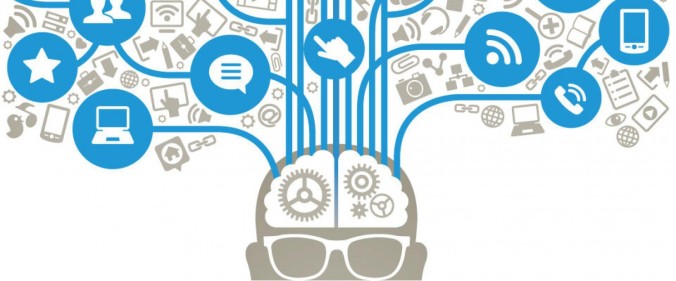 In my opinion a digital world can be described as the way our lives are connected through digital devices or media and how much we rely on them. Technology influences our lives more than we realize; we rely on it for travel, communication and even just the foods we eat.
In my opinion a digital world can be described as the way our lives are connected through digital devices or media and how much we rely on them. Technology influences our lives more than we realize; we rely on it for travel, communication and even just the foods we eat.



As technology evolves, we are becoming more reliant on our digital devices as they make our lives more practical and convenient. Technology such as smartphones, iPads, computers, laptops and GPS’s are just a few examples of devices that we rely on in our digital world to make our life easier.

Each generation is becoming more reliant on technology, and our digital world is expanding rapidly. It is important as educators that we are able to use technology to its full potential. Teachers can use different apps to communicate with students, set projects, and add fun into the classroom. The digital world also allows teachers from all over Australia to be able to communicate, enabling them to share efficient ways of using technology within the classroom. Though a negative of technology is that every school has access to different resources, it is important that teachers utilize what is provided. The digital world will only continue to grow so it is important that we embrass it rather than resist it.

Obviously there will always be positives and negatives to the technology we use, especially when considering the way we use social media. “According to a survey conducted by Common Sense Media in 2012, 52 percent of teens ages 13 to 17 said that social media helps build their friendships, and 88 percent said that it helps them keep in touch with friends they can’t see every day.” However teachers need to be aware of the negative effects this can have on the school environment such as cyber bullying. Teachers must ensure that the technology that allow in the classroom effects their students in a positive way from an educational and social perspective.
References
Spotlight, 2017, Allie Jamersom, Anthony Kaiser, Mr. Troy Ruch, Quint Hansen, http://slspotlight.com/our-world/2016/12/19/pros-and-cons-of-the-digital-world/
Visual component
Digital identities and digital security
Access my YouTube account and view: https://youtu.be/m3dk4wUJH7k
What is a digital identity?
“Digital identity is the network or Internet equivalent to the real identity of a person or entity (like a business or government agency) when used for identification in connections or transactions from PCs, cell phones or other personal devices” (gemalto, 2016) Digital identity be used to verify your actual identity for example being sent an email when joining a website, it can be used as a foundation to future employers to explore who you are and it may also be your social media accounts; the way you poetry yourself online to your friends, families and acquaintances.
Why is digital identity important?
It is important to understand that once something is posted online, chances are it’s there forever, this can be referred to as a digital tattoo or footprint. In the classroom, teachers must make students aware that any pictures they post and websites they visit contribute to their digital identity. They must also be made aware of the importance of protecting their digital identity. That brings us to the topic of digital security.
What is digital security?
“Digital security is the protection of your digital identity – the network or Internet equivalent of your physical identity. Digital security includes the tools you use to secure your identity, assets and technology in the online and mobile world.” (gemalto, 2016)
As the use of the internet continues to grow, so does the importance of securing your personal digital devices, using anti-viral software and the use of passwords for all online accounts. Techers can ensure students create passwords for their computers and all online accounts used in school encouraging good habits regarding digital security.
Overall, in today’s society anyone active online has created a digital identity, and it is vital that they are aware of the importance of online image, and also how to ensure they are using the internet safely.
References
gemalto, 2016 https://www.justaskgemalto.com/en/what-is-digital-identity/
gemalto, 2016 https://www.justaskgemalto.com/us/what-digital-security /
AUDITORY CONTENT OF ASSESSMENT
Digital fluency
URL: https://youtu.be/bdXnOnewQ9k
Firstly, what is digital fluency? Digital fluency can be described as the skill level and ability of students to use digital technology, in other words, digital competence. These technologies can include different programs and products, the ability to use the internet efficiently, the use of technological language amongst many other things. it is important that not only the students, but you as a teacher work to become as digitally fluent as possible. But why is it important for students to become digitally fluent? Resnick said that “In the years ahead, digital fluency will become a prerequisite for obtaining jobs, participating meaningfully in society, and learning throughout a lifetime. (Resnick, 2002, p. 33) [via White, 2013]”
Every student you teach will be at a different level of understanding when it comes to technology. Their level of understanding is often influenced by their age, and exposure to technology outside of school. However, there should be an expected level of digital fluency for each year group, and as a teacher you are required to ensure students reach their full potential. The internet is becoming increasingly relied upon in today’s society, from communication to school projects. The information that becomes available to a digitally fluent student will allow them to further explore vast amounts of information, and engage in more effective learning. To be considered digitally fluent in a classroom environment depends on the year level of the student. Obviously, a secondary student will have a larger skill set than a primary schooler. As a teacher you must understand, and adapt to this. Each task that a teacher sets can improve a student’s digital fluency. This can be done through introducing different apps, new terminology and setting task that require the use of the internet.
Overall, the importance of digital fluency is growing not only within the classroom, but within society and it is important for teachers to allow and encourage this growth.
References
Core blog, What is Digital Fluency, 2016, http://blog.core-ed.org/blog/2015/10/what-is-digital-fluency.html
Teaching with ICT digital Pedagogies for collaboration and creativity, Jenifer Howell, 2012
Reflection
With the digital world being one of my topics I’ve come to realise what an important influence technology has on education in today’s day and age. The amount of exposure children receive to the digital world is almost frightening. However, as I looked into digital identitys and digital security I reaslie there is a safe and effective way of using the internet. I discovered that it is my responsibility as a teacher to ensure that students become digitally fluent as it not only effects the students schooling career, but their future out of school. While completing this assignment realized that as a student I was not exposed to many different technologies, and I struggled with using a variety of apps. I will keep this in mind in the future to ensure I expose my students to as much of what the internet has to offer as I can so that I can to help them better prepare for their future. I also realized the importance of digital security as it came to my attention how accessible information is over the internet. The applications I used were WordPress wave pad and open shot video editor. WordPress was a straight forward app once I understood it, though it was my first ever blog so it was a new experience. I found open shot easy to work with and to upload my film to the internet. However, uploading my audio file from wave pad was a challenge as I had to convert it to a movie format to upload it to the internet.
Overall I found this task to be reasonably enjoyable and challenging, and id definitely consider using a similar task in me teaching future!
Reference
Teaching with ICT digital Pedagogies for collaboration and creativity, Jenifer Howell, 2012


